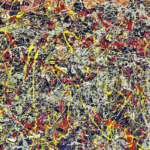Second Generation Artists
Abstract Expressionism, initially developed in the 1940s, saw its full bloom in the 1950s, primarily in New York City. The movement emphasized spontaneous, automatic, or subconscious creation, focusing on the process of making art as much as the finished product. The first generation of Abstract Expressionists, including giants like Jackson Pollock and Willem de Kooning, laid the groundwork for this radical approach. However, it was the second generation of Abstract Expressionists who expanded and diversified the movement, infusing it with new ideas, techniques, and sensibilities.

Characteristics of Second Generation Abstract Expressionism
1. Diverse Techniques and Mediums
The second generation of Abstract Expressionists did not limit themselves to traditional painting. They experimented with various mediums, including collage, printmaking, and assemblage, which allowed for more varied textures and forms in their work.
2. Personal and Political Themes
In the backdrop of social and political changes during the 1950s and 1960s, many second-generation artists infused their work with personal and political themes. They used abstraction to explore issues such as identity, power, and social justice.
3. Emphasis on Process and Materiality
For many of these artists, the process of creation was as significant as the artwork itself. This led to a focus on materiality—the physical properties of the materials used in the artwork. Artists like Joan Mitchell and Helen Frankenthaler celebrated the tactile qualities of paint and canvas.
4. Integration with Other Movements
Second-generation Abstract Expressionists often blended elements of Abstract Expressionism with other contemporary movements such as Minimalism, Pop Art, and Conceptual Art. This resulted in a rich and diverse body of work that continued to evolve the principles of abstraction.
Top 25 Second Generation Abstract Expressionists
1. Joan Mitchell
Joan Mitchell’s vibrant, gestural paintings often draw inspiration from nature. Her works are characterized by energetic brushstrokes and a rich color palette, conveying intense emotion and movement.
2. Helen Frankenthaler
Known for her “soak-stain” technique, Helen Frankenthaler poured thinned paint onto unprimed canvas, creating luminous, atmospheric works celebrated for their ethereal beauty.
3. Sam Francis
Sam Francis’s dynamic compositions and vibrant use of color feature splashes, drips, and stains, creating a sense of movement and energy.
4. Grace Hartigan
Grace Hartigan blended abstraction with elements of figuration, drawing inspiration from contemporary culture and personal experiences. Her bold, expressive style is evident in her powerful compositions.
5. Alfred Leslie
Alfred Leslie’s early abstract works are marked by bold, gestural brushstrokes and a vivid palette. He later transitioned to more figurative work but remained influential in abstraction.
6. Michael Goldberg
Michael Goldberg’s abstract paintings are characterized by energetic brushstrokes and vibrant colors, creating a dynamic interplay of form and color.
7. Norman Bluhm
Norman Bluhm’s abstract paintings feature bold, gestural brushstrokes and dynamic compositions, conveying a sense of spontaneity and emotional intensity.
8. Perle Fine
Perle Fine’s works are characterized by their delicate balance of color and form, often exploring themes of nature and human experience.
9. Mercedes Matter
A founder of the New York Studio School, Mercedes Matter combined abstract and representational elements, creating a dialogue between form and content.
10. Nassos Daphnis
Nassos Daphnis’s abstract works feature bold geometric shapes and vibrant colors, creating a sense of harmony and balance.
11. Judith Godwin
Judith Godwin’s gestural brushstrokes and vibrant use of color convey a sense of spontaneity and emotional intensity.
12. Edward Dugmore
Edward Dugmore’s abstract paintings are known for their bold colors and dynamic compositions, often exploring themes of movement and structure.
13. Mary Abbott
Mary Abbott’s abstract works feature vibrant colors and dynamic compositions, reflecting her interest in the natural world and personal expression.
14. Ernest Briggs
Ernest Briggs’s abstract paintings are characterized by gestural brushstrokes and vibrant use of color, conveying a sense of movement and emotion.
15. Richard Diebenkorn
Richard Diebenkorn’s work often transitions between abstraction and representation, with his “Ocean Park” series being particularly notable for its exploration of color and form.
16. Paul Brach
Paul Brach’s work features bold colors and dynamic compositions, reflecting his interest in abstraction and the human experience.
17. Morris Louis
Morris Louis, a pioneer of Color Field Painting, used staining techniques to create large, colorful canvases. His “Veil” series features delicate, layered colors that appear to flow and merge, emphasizing the movement’s focus on pure emotion and form.
18. Dorothy Dehner
Dorothy Dehner’s abstract sculptures and drawings explore themes of nature and human experience, blending abstraction with organic shapes.
19. Louise Nevelson
Esteban Vicente’s abstract paintings explore themes of light and space, using vibrant colors and dynamic compositions to create a sense of depth and movement.
20. Ray Parker
Ray Parker’s abstract paintings are characterized by bold colors and gestural brushstrokes, exploring themes of emotion and experience.
21. Friedel Dzubas
Friedel Dzubas’s abstract paintings feature vibrant colors and dynamic compositions, reflecting his engagement with the principles of Abstract Expressionism.
22. Sam Gilliam
Sam Gilliam is known for his innovative approach to abstract painting, often incorporating draped and folded canvases into his works.
23. John Chamberlain
John Chamberlain’s abstract sculptures, often composed of crushed car parts and industrial materials, explore themes of space, movement, and the human experience.
24. Stephen Pace
Stephen Pace’s abstract paintings are characterized by their bold colors and dynamic compositions, reflecting his engagement with the principles of Abstract Expressionism.
25. Ida Kohlmeyer
Ida Kohlmeyer’s abstract paintings often featured vibrant colors and dynamic compositions, exploring themes of emotion and experience through her masterful use of form and color.
The Legacy of Second Generation Abstract Expressionism
The second generation of Abstract Expressionists played a crucial role in expanding and diversifying the movement, building on the foundations laid by the first generation. They continued to explore the possibilities of abstraction, often integrating elements from other contemporary art movements and responding to the changing cultural and political landscapes of their time.
Institutional Recognition
The success of Abstract Expressionism led to increased recognition and support for American artists from major art institutions and collectors. Museums and galleries around the world began to showcase and acquire works by Abstract Expressionist artists, solidifying their place in art history.
Global Influence
While Abstract Expressionism originated in the United States, its impact was felt globally. Artists from around the world drew inspiration from the movement’s principles and techniques, contributing to a more interconnected and diverse art world.
Ongoing Relevance
The themes and techniques explored by the Abstract Expressionists remain relevant in contemporary art. Artists continue to experiment with abstraction, emotion, and the subconscious, building on the legacy of these pioneers.



